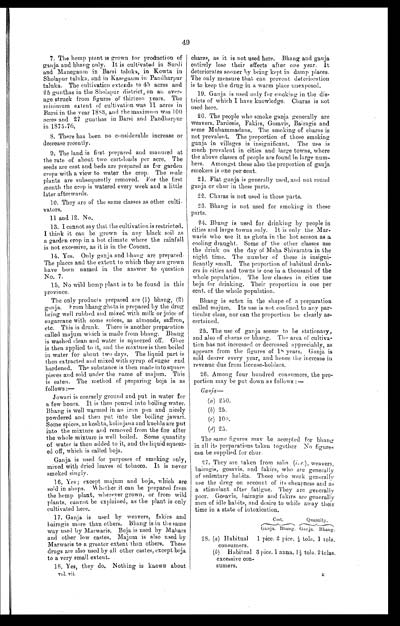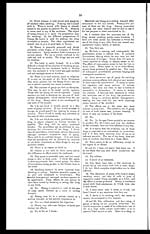Medicine - Drugs > Report of the Indian Hemp Drugs Commission, 1894-1895 > Volume VII > Evidence of Bombay witnesses
(67) Page 49
Download files
Individual page:
Thumbnail gallery: Grid view | List view

49
7. The hemp plant is grown for production of
ganja and bhang only. It is cultivated in Surdi
and Manegaum in Barsi taluka, in Kowta in
Sholapur taluka, and in Kasegaum in Pandharpur
taluka. The cultivation extends to 45 acres and
25 gunthas in the Sholapur district, on an aver-
age struck from figures of thirteen years. The
minimum extent of cultivation was 11 acres in
Barsi in the Year 1883, and the maximum was 100
acres and 27 gunthas in Barsi and Pandharpur
in 1875-76.
8. There has been no considerable increase or
decrease recently.
9. The land is first prepared and manured at
the rate of about two cart-loads per acre. The
seeds are cast and beds are prepared as for garden
crops with a view to water the crop. The male
plants are subsequently removed. For the first
month the crop is watered every week and a little
later afterwards.
10. They are of the same classes as other culti-
vators.
11 and 12. No.
13. I cannot say that the cultivation is restricted.
I think it can be grown in any black soil as
a garden crop in a hot climate where the rainfall
is not excessive, as it is in the Concan.
14. Yes. Only ganja and bhang are prepared.
The places and the extent to which they are grown
have been named in the answer to question
No. 7.
15. No wild hemp plant is to be found in this
province.
The only products prepared are (1) bhang, (2)
ganja. From bhang ghota is prepared by the drug
being well rubbed and mixed with milk or juice of
sugarcane with some spices, as almonds, saffron,
etc. This is drunk. There is another preparation
called majum which is made from bhang. Bhang
is washed clean and water is squeezed off. Ghee
is then applied to it, and the mixture is then boiled
in water for about two days, The liquid part is
then extracted and mixed with syrup of sugar and
hardened. The substance is then made into square
pieces and sold under the name of majum. This
is eaten. The method of preparing boja is as
follows: —
Jowari is coarsely ground and put in water for
a few hours. It is then poured into boiling water.
Bhang is well warmed in an iron pan and nicely
powdered and then put into the boiling jawari.
Some spices, as koshta, kolinjana and kuchla are put
into the mixture and removed from the fire after
the whole mixture is well boiled. Some quantity
of water is then added to it, and the liquid squeez-
ed off, which is called boja.
Ganja is used for purposes of smoking only,
mixed with dried leaves of tobacco. It is never
smoked singly.
16. Yes; except majum and boja, which are
sold in shops. Whether it can be prepared from
the hemp plant, wherever grown, or from wild
plants, cannot be explained, as the plant is only
cultivated here.
17. Ganja is used by weavers, fakirs and
bairagis more than others. Bhang is in the same
way used by Marwaris. Boja is used by Mahars
and other low castes. Majum is also used by
Marwaris to a greater extent than others. These
drugs are also used by all other castes, except boja
to a very small extent.
18. Yes, they do, Nothing is known about
charas, as it is not used here. Bhang and ganja
entirely lose their effects after one year, It
deteriorates sooner by being kept in damp places.
The only measure that can prevent deterioration
is to keep the drug in a warm place unexposed.
19. Ganja is used only for smoking in the dis-
tricts of which I have knowledge. Charas is not
used here.
20. The people who smoke ganja generally are
weavers, Pardesis, Fakirs, Gosavis, Bairagis and
some Muhammadans. The smoking of charas is
not prevalent. The proportion of those smoking
ganja in villages is insignificant. The use is
much prevalent in cities and large towns, where
the above classes of people are found in large num-
bers. Amongst these also the proportion of ganja
smokers is one per cent.
21. Flat ganja is generally used, and not round
ganja or chur in these parts.
22. Charas is not used in these parts.
23. Bhang is not used for smoking in these
parts.
24. Bhang is used for drinking by people in
cities and large towns only. It is only the Mar-
waris who use it as ghota in the hot season as a
cooling draught. Some of the other classes use
the drink on the day of Maha Shivaratra in the
night time. The number of these is insigni-
ficantly small. The proportion of habitual drink-
ers in cities and towns is one in a thousand of the
whole population. The low classes in cities use
boja for drinking. Their proportion is one per
cent. of the whole population.
Bhang is eaten in the shape of a preparation
called majum. Its use is not confined to any par-
ticular class, nor can the proportion be clearly as-
certained.
25. The use of ganja seems to be stationary,
and also of charas or bhang. The area of cultiva-
tion has not increased or decreased appreciably, as
appears from the figures of 18 years, Ganja is
sold dearer every year, and hence the increase in
revenue due from license-holders.
26. Among four hundred consumers, the pro-
portion may be put down as follows: —
Ganja—
(a) 250.
(b) 25.
(c) 100.
(d) 25.
The same figures may be accepted for bhang
in all its preparations taken together. No figures
can be supplied for chur.
27. They are taken from salis (i.e.), weavers,
bairagis, gosavis, and fakirs, who are generally
of sedentary habits. Those who work generally
use the drug on account of its cheapness and as
a stimulant after fatigue. They are generally
poor. Gosavis, bairagis and fakirs are generally
men of idle habits, and desire to while away their
time in a state of intoxication.
| Cost. | Quantity. | ||||
| Ganja. | Bhang. | Ganja. | Bhang. | ||
| 28. | (a) Habitual consumers. | 1 pice. | 2 pice. | ½ tola. | 1 tola. |
| (b) Habitual excessive con- sumers. | 3 pice. | 1 anna. | 1½ tola. | 2 tolas. | |
vol. vii.
K
Set display mode to: Large image | Zoom image | Transcription
Images and transcriptions on this page, including medium image downloads, may be used under the Creative Commons Attribution 4.0 International Licence unless otherwise stated. ![]()
| India Papers > Medicine - Drugs > Report of the Indian Hemp Drugs Commission, 1894-1895 > Volume VII > Evidence of Bombay witnesses > (67) Page 49 |
|---|
| Permanent URL | https://digital.nls.uk/74910714 |
|---|




